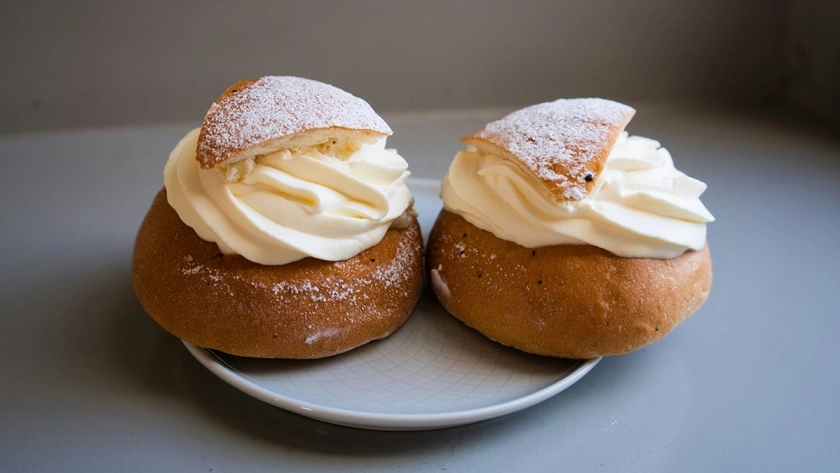
Fettisdagen in a few words
Fettisdagen (Shrove Tuesday) is a Christian tradition that marks the last days before Lent, a 40-day period of fasting and penance before Easter. For both Catholics and Protestants, in order to better face the long period of austerity, people indulge in fatty and sweet foods. Instead of pancakes and doughnuts, Swedes eat semlas on this day: sweet pastries filled with whipped cream and almond paste, often served in a small brioche bun flavored with cardamom.
Fettisdagen used to be the peak of a three-day celebration during which people gorged themselves before the 40-day fast: the Sunday before Fettisdagen, called "Fastlagssöndagen" (Candlemas Sunday), the Monday, known as "Blåmåndagen" (Blue Monday), and Tuesday, known as Shrove Tuesday or Fettisdagen, which was the actual big feast day when people prepared by stocking up on fatty foods.

The following Wednesday, known as Ash Wednesday (askondagen in Swedish), got its name from the practice of spreading ash on one's head to signify repentance for sins, and it marked the beginning of the period of Lent, which ended with the Easter celebration (the resurrection of Christ).
The semla in all its forms: from the simple bread roll to the indulgent stuffed brioche
However, it seems that the semla arrived in Sweden with no direct connection to Christianity, and originally, it was simply a smooth, non-spiced wheat bread, without almond paste or whipped cream. The first time the semla is mentioned in a Christian context is in the Bible of Gustaf Vasa, in 1541.
In the 16th century, semlor (the plural of semla in Swedish) were only consumed on Tuesdays during Lent. Shrove Tuesday, or Semla Tuesday, takes place seven weeks before Easter, and semlor were eaten in large quantities on this day, before the fast began. When Lent Fasting disappeared, but people continued to eat semlor, but now on every Tuesday until Easter. The reason why semlor started being filled in the 16th century is believed to be that during Lent, people were only allowed to eat bread, and so the bread was filled with delicious whipped cream and energizing butter every Tuesday.
In the 18th century, according to tradition, the semla was sometimes dipped in hot milk – a mixture known as "semla i mjölk" (literally, "semla in milk") or "hetvägg" (a term derived from the German "Heisse Wacken” , where "het" means hot and "vägg" (from the German "wegge") refers to the shape of the small bread (triangles or crosses), so that they could be arranged in a circle at the bottom of a pot. Just before cooking the semlor in the hot milk, they were also filled with cream and butter.
From the 1850s onwards, the method of cooking semlor in hot milk was replaced by serving them with hot milk on the side. It was also during this time that they began to be filled in an even more indulgent manner: with almond cream and flavored with cinnamon and sugar. Spices became much more popular, and cardamom, with its fresh and slightly lemony aroma, became a traditional ingredient in the semla dough.
Today, cardamom is considered a key ingredient in semla, and its presence in the dough helps give this Swedish pastry a distinct flavor that sets it apart from similar pastries around the world. This is part of Swedish traditions that have evolved over time while remaining true to their roots.
The semla responsible for King Frederick Adolf’s death?
On February 12, 1771, on Fat Tuesday, Swedish King Adolf Fredrik died from indigestion after consuming 14 semlor, according to legend... Adolf Fredrik was indeed a great lover of hunting and food, but the night before this fateful meal, the king and queen were at a ball at the Ulriksdal Palace. It’s said that the king hurried back to the castle because his French head chef had promised to serve him "hetvägg," which were the semlor of the time, with cinnamon and hot milk.
The day after the ball, the queen was still drunk, so King Adolf Fredrik dined alone. He started with oysters, followed by sauerkraut, meat with turnips, lobster, caviar, smoked herring, and plenty of champagne. When he was truly full, he turned to his favorite dish—semlor. It is said he ate 14. Immediately after this hearty meal, the king let out a cry, and his servants carried him to a bed where he breathed his last.
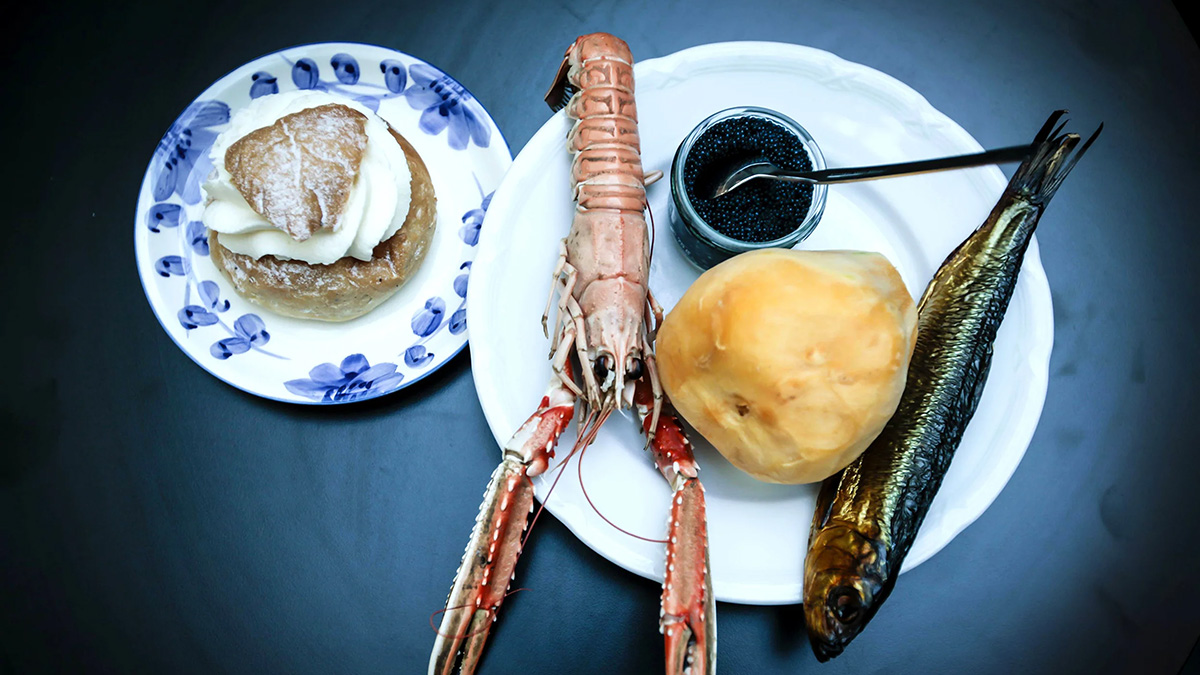
The cause of his death is likely a stroke, and it is entirely possible that this heavy meal contributed to it, but there is no evidence to suggest that the semlor specifically caused the king's death. Furthermore, in the 18th century, the semlor were not as rich as they are today—they did not contain whipped cream or almond paste.
A date that varies and increasingly extravagant semlor
The date of Fettisdagen varies each year depending on the liturgical calendar, but it always falls on a Tuesday, often between February and March. This year, 2025, for example, Fettisdagen falls on March 4th. Although the classic version of the semla, filled with almond cream and whipped cream, is the most common, today there are many variations: with nuts or pistachios, flavored and colored. Some people opt for semlor filled with chocolate mousse or caramel, while others choose gluten-free or vegan versions. There are also hybrids with other pastries: prinsesstårta and semla, croissant and semla, chocolate ball and semla...

Swedes are always creative when it comes to personalizing this tradition, and some restaurants take on challenges where the semla becomes even more extravagant, with unusual toppings or an XXL size.
The semla and swedish culture
The semla is much more than just a pastry; it is an integral part of Swedish culture. Every year, the "semla season" sparks a sort of culinary "fever," where every family or establishment tries to create the best version of the semla. It is a tradition that brings people together and allows them to honor Swedish heritage while enjoying the simple pleasures of life. Swedish media are also eager to cover the latest trends in semlor. For example, competitions are organized to choose the best semla of the year.
This tradition of tasting and sharing is a way for Swedes to reconnect with their roots while celebrating camaraderie and indulgence. In this article, we present our top 5 bakeries/patisseries for a good semla. Prices range from 45 to 70 SEK depending on the location.
1. For a classic semla
If you want to experience the classic semla with cardamom brioche, almond paste, and whipped cream, all freshly made that day, we recommend visiting two historic addresses in Stockholm: the Patisserie Vetekatten located in Norrmalm or the Tosse bakery located in Östermalm.

You won’t be disappointed, as both establishments, while following the classic recipe, add their own nuances to this traditional dessert, each with a slightly different interpretation that adds to the charm of the semla in Stockholm. Vetekatten’s semla stands out with a denser and more generously filled brioche, with a thicker almond paste and light whipped cream (sometimes flavored with vanilla). On the other hand, Tossebageriet's semla is characterized by a lighter and airier brioche, with superior-quality almond paste and truly delicate whipped cream.
Tossebageriet is also very famous for its semmelwrap, a semla presented in a roll form, where the dough is spread out and then wrapped around the filling. It’s filled with almond paste and light whipped cream, just like the traditional semla, but the "wrap" format makes it more practical to enjoy, while still retaining the richness and sweetness of the classic version.
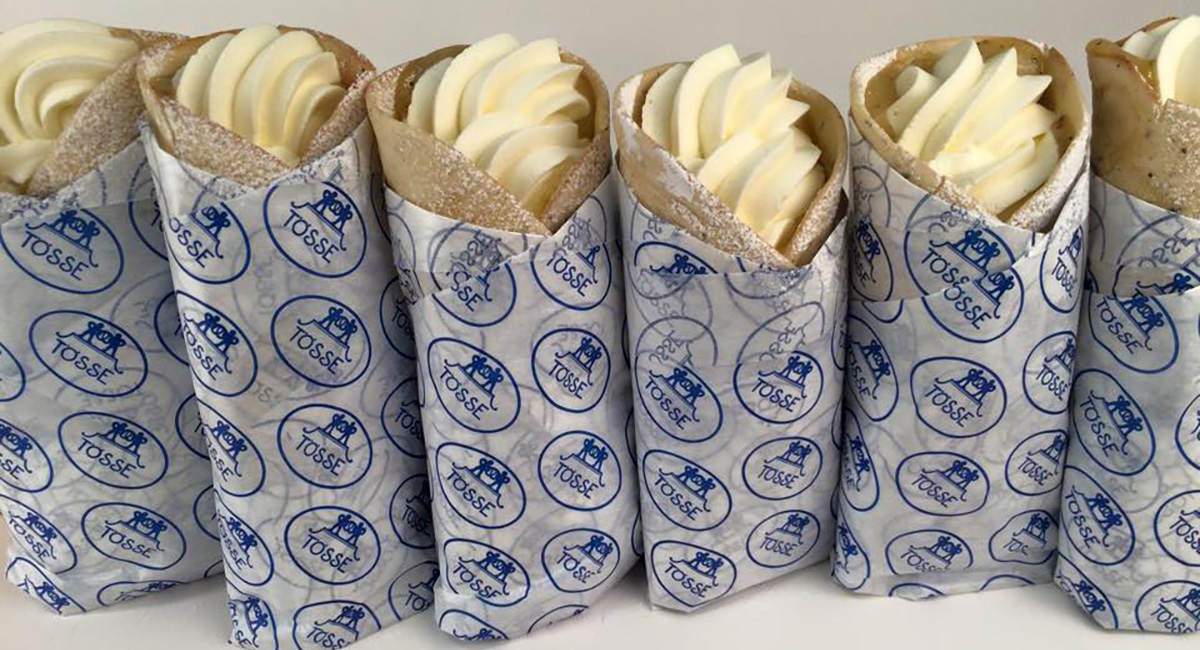
This contemporary twist offers a slightly different indulgent experience, while still staying true to the flavors of traditional Swedish pastry.
2. For a 100% organic but crunchier semla
Skeppsbro Bageri is an artisanal 100% organic bakery. Their breads are made with sourdough and baked in a wood-fired oven. The dough ferments for at least one day in the fridge before baking, which gives it more flavor and makes it softer. Although they focus mainly on bakery products, such as bread and pastries, they also create iconic treats like semlor. They offer them in a classic version, a croissant version, and even a crunchier version where crushed almonds are added to the almond paste for an even more pronounced almond flavor.
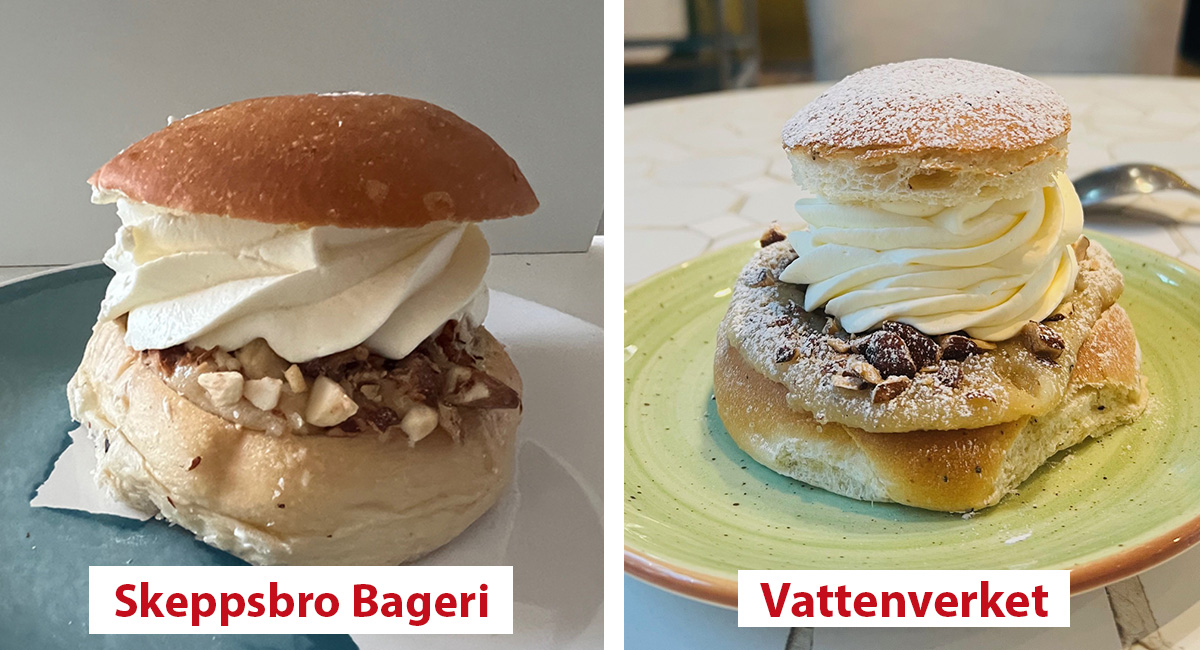
The whipped cream is truly delicious (slightly vanilla-flavored) and contrasts with the rather sweet and dense brioche and the indulgence of the almond paste. The crushed almonds all around the semla make the experience unique. Another café/bakery located in Lidingö, called Vattenverket, also offers crunchy semlas with the same expertise in baking (natural fermentation).
However, the small but important difference lies in the firmer whipped cream and the preparation of the almonds, which are slightly caramelized, adding an extra crunch. The brioche is also lighter and more airy. Finally the location itself—an enchanting setting in nature—adds something special to enjoying your semla.
3. The semla, a work of art
After the bakery, let's move on to the pastry artists and their aesthetic and culinary interpretation of the semla. Two patisseries in Stockholm stand out for their refined and high-quality pastries... The French Fosch (Damien Foschiatti) located in Östermalm and the Swedes from Socker Sucker (Frida Bäcke and Bedros Kabranian) located in Norrmalm. While both of these pastry chefs pay particular attention to aesthetics and the reinterpretation of the recipe, their way of elevating each creation to bring out the best is a common trait. When it comes to the semla, their commonality lies in the quality of the brioche (both are also bakers) but also in the almond paste, which is delightfully crunchy, made of caramelized crushed almonds that pair perfectly with a light brioche and a whipped cream that is not flavored but wonderfully creamy
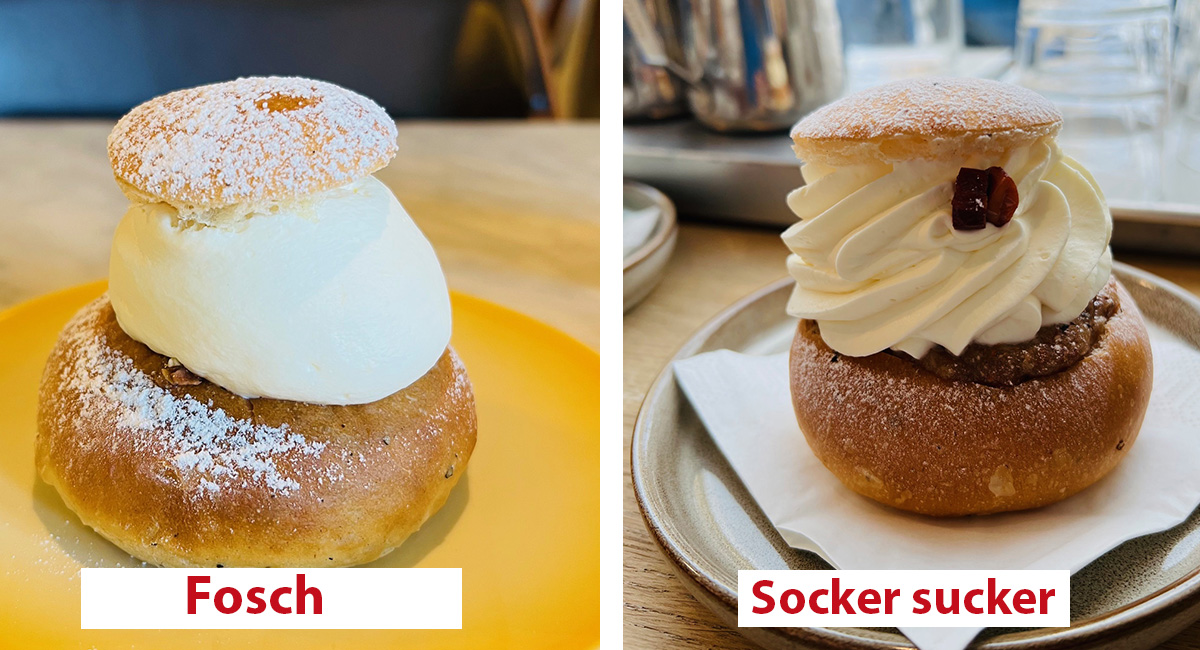
The one from Socker Sucker is much more indulgent (in size and quantity), and a few caramelized almondsenhance the whipped cream. However, the almond cream itself is more blended and less crunchy than Fosch's. The cream in Fosch's semla is more whipped than just aerated, and the almond cream is truly crunchy, contrasting with the very soft brioche. The price also differs significantly: Fosch's semla costs 50 SEK, while Socker Sucker's costs 60 SEK.
4. Eataly: The italian interpretation
Pistachio is trending this year all over Europe, but for Italians, pistachio is not just a trend; it's an essential and traditional ingredient, deeply rooted in their culinary culture, especially in the south of Italy. This pistachio semla is an attempt to "Italianize" a Swedish recipe: the cream is a panna montata (Italian whipped cream), rich and less firm than Swedish grädde (cream), but the pistachio is unfortunately more decorative than truly flavorful.
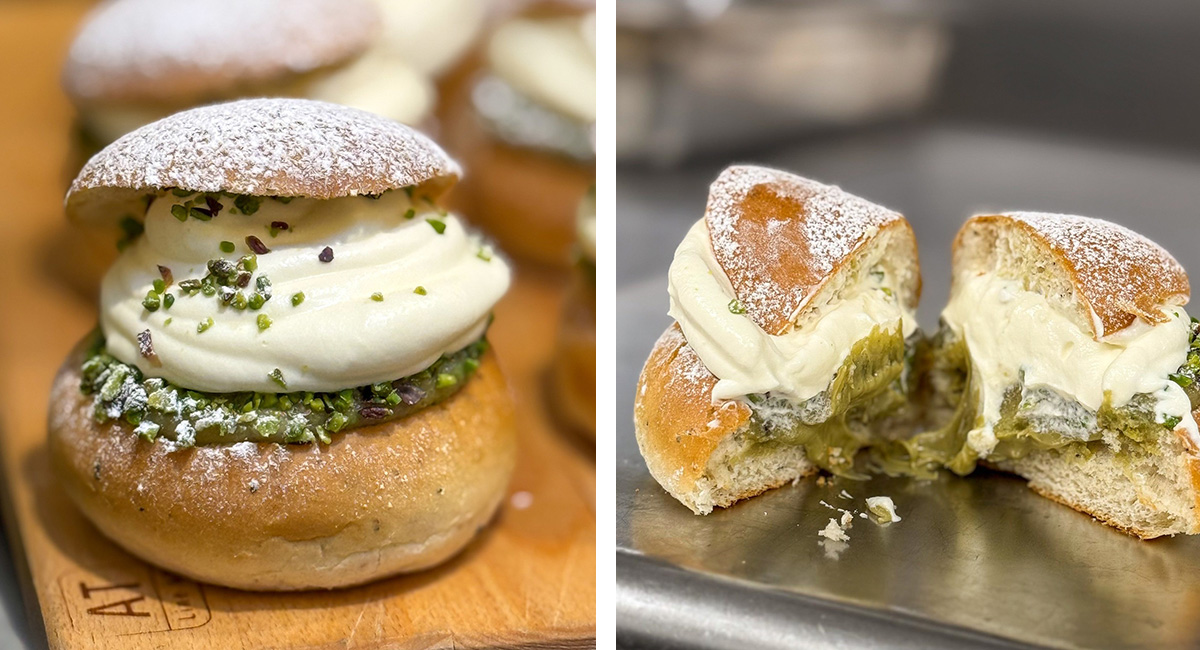
The brioche is also somewhat of industrial quality, with no pistachio flavor. The almond cream is replaced by a pistachio cream, without any pistachio pieces, quite sweet—a semla that looks tempting visually but whose quality is more than questionable.
5. Ritorno: a relevant variation of the semla
Finally, another historic establishment in Stockholm, called Ritorno, located in Vasastan and founded in 1959, offers a very original semla with licorice. Known for its warm atmosphere and 1950s retro decor (yellow walls, red chairs, and crystal chandeliers), the café-patisserie has been serving this bold recipe for several years now, and it is very popular.
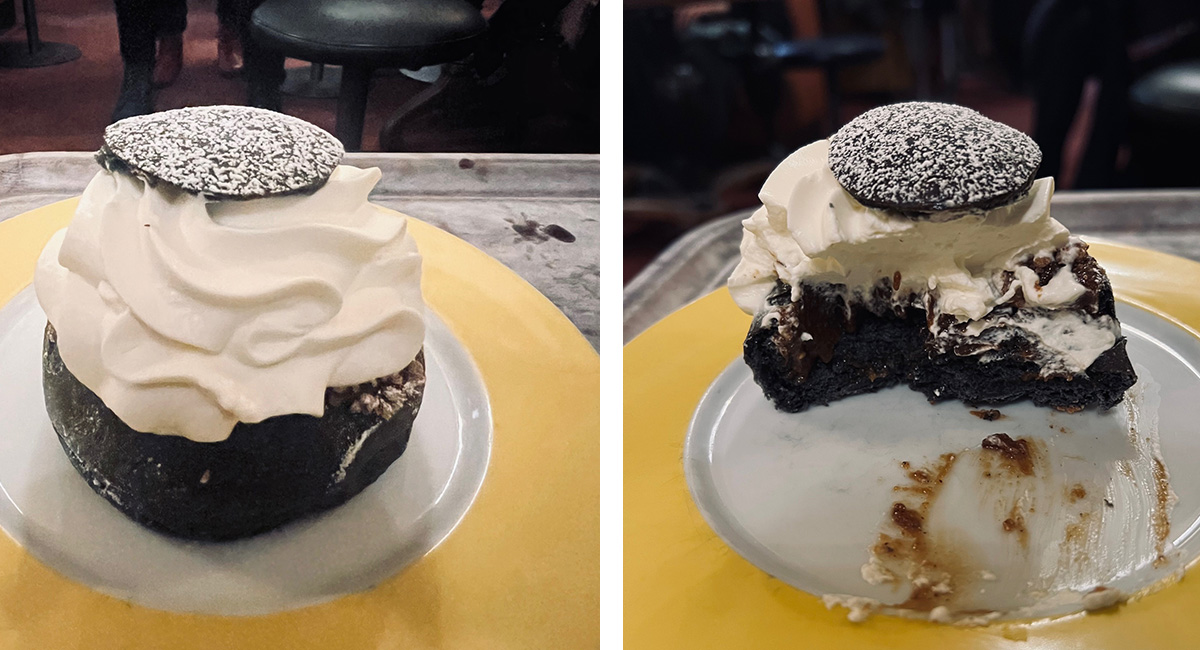
In this version, the brioche is flavored with licorice, and the almond cream is replaced by licorice cream, offering a unique and slightly aniseed flavor. Licorice is a highly appreciated ingredient in Scandinavia, especially in Sweden, where it is used in various candies and food products. This licorice semla combines the light, fluffy texture of the semla with a bold and original touch of licorice, adding a sweet and tangy note that appeals to those who enjoy this distinctive taste. It’s a variation that delights food lovers looking for new flavor experiences.
 en
en FR
FR IT
IT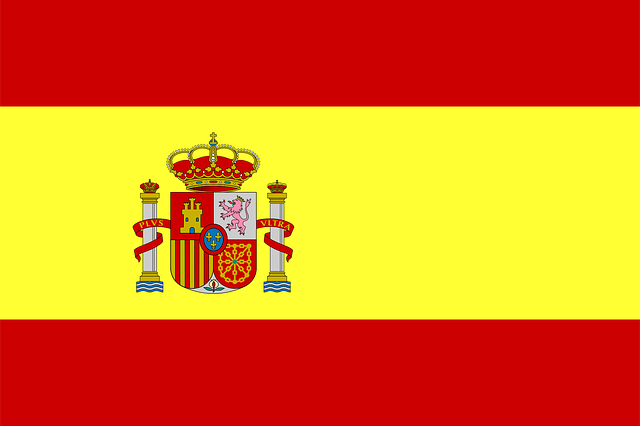 ES
ES
